A Low-Cost Foot-Placed UWB and IMU Fusion-Based Indoor Pedestrian Tracking System for IoT Applications
Abstract
1. Introduction
- We propose a low-cost foot-placed UWB and IMU fusion-based indoor pedestrian tracking system to overcome the practical limitations of UWB and IMU wearable sensors. Our data fusion model processes the valid UWB observation by inspecting the residual error to exclude any NLOS instances. As a result, it tackles the UWB’s indoor NLOS and IMU’s accumulated drift issues; it provides a simple but effective indoor pedestrian tracking solution for IoT applications.
- The system hardware is built using off-the-shelf devices. We assembled a prototype of a foot-placed UWB and IMU module to shape a compact-sized battery-powered wearable IoT device, in addition to reducing its cost by up to USD 40, and to incorporate the open-platform software for facilitating the flexible data handling needs of an IoT use case with no additional expense.
- The performance of our system is validated using a Hokuyo Lidar in comparison with an IMU-based PDR, raw UWB position, and conventional fusion model. We conducted two experimental scenarios, a single-lap NLOS and a multi-lap LOS+NLOS, in a complex indoor environment to demonstrate the robustness of our solution against the UWB indoor NLOS and IMU long-term drift.
2. Materials and Methods
2.1. System Hardware and Data Acquisition
2.1.1. UWB Sensor Characterization
2.1.2. Working Principle of UWB Positioning System
2.1.3. Wearable IoT Device: A Low-Cost Foot-Placed UWB and IMU Module
2.2. Proposed UWB and IMU Fusion Structure
2.2.1. Strap-Down Mechanism
2.2.2. ILCKF Prediction Stage
2.2.3. ILCKF Correction Stage1: ZUPT
2.2.4. ILCKF Correction Stage2: UWB Observation Update
3. Experiment Description
3.1. Experimental Setup
3.2. Data Handling at Central Computer
3.3. Performance Criteria
4. Experiment Results
4.1. Single-Lap NLOS Scenario
4.2. Multi-Lap LOS+NLOS Scenario
5. Discussion and Future Work
6. Conclusions
Author Contributions
Funding
Institutional Review Board Statement
Informed Consent Statement
Data Availability Statement
Conflicts of Interest
References
- Qadri, Y.A.; Nauman, A.; Zikria, Y.B.; Vasilakos, A.V.; Kim, S.W. The Future of Healthcare Internet of Things: A Survey of Emerging Technologies. IEEE Commun. Surv. Tutor. 2020, 22, 1121–1167. [Google Scholar] [CrossRef]
- Ahmad, I.; Asghar, Z.; Kumar, T.; Li, G.; Manzoor, A.; Mikhaylov, K.; Shah, S.A.; Höyhtyä, M.; Reponen, J.; Huusko, J.; et al. Emerging Technologies for Next Generation Remote Health Care and Assisted Living. IEEE Access 2022, 10, 56094–56132. [Google Scholar] [CrossRef]
- Khalil, U.; Malik, O.A.; Uddin, M.; Chen, C.-L. A Comparative Analysis on Blockchain versus Centralized Authentication Architectures for IoT-Enabled Smart Devices in Smart Cities: A Comprehensive Review, Recent Advances, and Future Research Directions. Sensors 2022, 22, 5168. [Google Scholar] [CrossRef]
- Basiri, A.; Lohan, E.S.; Moore, T.; Winstanley, A.; Peltola, P.; Hill, C.; Amirian, P.; e Silva, P.F. Indoor location based services challenges, requirements and usability of current solutions. Comput. Sci. Rev. 2017, 24, 1–12. [Google Scholar] [CrossRef]
- Lee, D.W.; Jun, K.; Naheem, K.; Kim, M.S. Deep Neural Network-Based Double-Check Method for Fall Detection Using IMU-L Sensor and RGB Camera Data. IEEE Access 2021, 9, 48064–48079. [Google Scholar] [CrossRef]
- Pöhlmann, S.T.; Harkness, E.F.; Taylor, C.J.; Astley, S.M. Evaluation of Kinect 3D Sensor for Healthcare Imaging. J. Med. Biol. Eng. 2016, 36, 857–870. [Google Scholar] [CrossRef]
- Liu, B.; Cai, H.; Ju, Z.; Liu, H. RGB-D Sensing Based Human Action and Interaction Analysis: A Survey. Pattern Recognit. 2019, 94, 1–12. [Google Scholar] [CrossRef]
- Jao, C.-S.; Abdallah, A.A.; Chen, C.; Seo, M.-W.; Kia, S.S.; Kassas, Z.M.; Shkel, A.M. PINDOC: Pedestrian Indoor Navigation System Integrating Deterministic, Opportunistic, and Cooperative Functionalities. IEEE Sens. J. 2022, 14, 14424–14435. [Google Scholar] [CrossRef]
- Niu, X.; Liu, T.; Kuang, J.; Li, Y. A Novel Position and Orientation System for Pedestrian Indoor Mobile Mapping System. IEEE Sens. J. 2021, 21, 2104–2114. [Google Scholar] [CrossRef]
- Gu, Y.; Lo, A.; Niemegeers, I. A Survey of Indoor Positioning Systems for Wireless Personal Networks. IEEE Commun. Surv. Tutor. 2009, 11, 13–32. [Google Scholar] [CrossRef]
- Naheem, K.; Elsharkawy, A.; Koo, D.; Lee, Y.; Kim, M. A UWB-Based Lighter-Than-Air Indoor Robot for User-Centered Interactive Applications. Sensors 2022, 22, 2093. [Google Scholar] [CrossRef] [PubMed]
- Elsharkawy, A.; Naheem, K.; Koo, D.; Kim, M.S. A UWB-Driven Self-Actuated Projector Platform for Interactive Augmented Reality Applications. Appl. Sci. 2021, 11, 2871. [Google Scholar] [CrossRef]
- Zampella, F.; Jimenez, R.A.R.; Seco, F. Robust Indoor Positioning Fusing PDR and RF Technologies: The RFID and UWB Case. In Proceedings of the 2013 International Conference on Indoor Positioning and Indoor Navigation (IPIN), Montbeliard-Belfort, France, 28–31 October 2013; pp. 1–10. [Google Scholar]
- Barral, V.; Escudero, C.J.; García-Naya, J.A.; Maneiro-Catoira, R. NLOS Identification and Mitigation Using Low-Cost UWB Devices. Sensors 2019, 19, 3464. [Google Scholar] [CrossRef]
- Jiménez, A.R.; Seco, F. Improving the Accuracy of Decawave’s UWB MDEK1001 Location System by Gaining Access to Multiple Ranges. Sensors 2021, 21, 1787. [Google Scholar] [CrossRef] [PubMed]
- Elsanhoury, M.; Mäkelä, P.; Koljonen, J.; Välisuo, P.; Shamsuzzoha, A.; Mantere, T.; Elmusrati, M.; Kuusniemi, H. Precision positioning for smart logistics using ultra-wideband technology-based indoor navigation: A review. IEEE Access 2022, 10, 44413–44445. [Google Scholar] [CrossRef]
- Borenstein, J.; Ojeda, L.; Kwanmuang, S. Heuristic Reduction of Gyro Drift in IMU-Based Personnel Tracking Systems. J. Navig. 2008, 62, 41–58. [Google Scholar] [CrossRef]
- Norrdine, A.; Kasmi, Z.; Blankenbach, J. Step Detection for ZUPT-Aided Inertial Pedestrian Navigation System using Foot-Mounted Permanent Magnet. IEEE Sens. J. 2016, 16, 6766–6773. [Google Scholar] [CrossRef]
- Li, J.; Liu, X.; Wang, Z.; Zhao, H.; Zhang, T.; Qiu, S.; Zhou, X.; Cai, H.; Ni, R.; Cangelosi, A. Real-Time Human Motion Capture Based on Wearable Inertial Sensor Networks. IEEE Internet Things J. 2022, 9, 8953–8966. [Google Scholar] [CrossRef]
- Eskofier, B.M.; Lee, S.I.; Baron, M.; Simon, A.; Martindale, C.F.; Gaßner, H.; Klucken, J. An Overview of Smart Shoes in the Internet of Health Things: Gait and Mobility Assessment in Health Promotion and Disease Monitoring. Appl. Sci. 2017, 7, 986. [Google Scholar] [CrossRef]
- Corrales Ramón, J.A.; Candelas-Herías, F.A.; Torres, F. Hybrid Tracking of Human Operators Using IMU/UWB Data Fusion by a Kalman Filter. In Proceedings of the 2008 3rd ACM/IEEE International Conference on Human-Robot Interaction (HRI), Amsterdam, The Netherlands, 12–15 March 2008; pp. 193–200. [Google Scholar]
- Hol, J.D.; Dijkstra, F.; Luinge, H.J.; Slycke, P.J. Tightly Coupled UWB/IMU Pose Estimation System and Method. US Patent US 2011/0025562 A1, 3 February 2011. [Google Scholar]
- Fischer, C.; Sukumar, P.T.; Hazas, M. Tutorial: Implementing a Pedestrian Tracker Using Inertial Sensors. IEEE Pervasive Comput. 2013, 12, 17–27. [Google Scholar] [CrossRef]
- Zihajehzadeh, S.; Park, E.J. A Novel Biomechanical Model-Aided IMU/UWB Fusion for Magnetometer-Free Lower Body Motion Capture. IEEE Trans. Syst. Man Cybern. Syst. 2016, 47, 927–938. [Google Scholar] [CrossRef]
- Zihajehzadeh, S.; Yoon, P.K.; Kang, B.-S.; Park, E.J. UWB-Aided Inertial Motion Capture for Lower Body 3-D Dynamic Activity and Trajectory Tracking. IEEE Trans. Instrum. Meas. 2015, 64, 3577–3587. [Google Scholar] [CrossRef]
- Zhang, H.; Zhang, Z.; Gao, N.; Xiao, Y.; Meng, Z.; Li, Z. Cost-Effective Wearable Indoor Localization and Motion Analysis via the Integration of UWB and IMU. Sensors 2020, 20, 344. [Google Scholar] [CrossRef]
- Zhang, Y.; Tan, X.; Zhao, C. UWB/INS Integrated Pedestrian Positioning for Robust Indoor Environments. IEEE Sens. J. 2020, 20, 14401–14409. [Google Scholar] [CrossRef]
- Nilsson, J.O.; Rantakokko, J.; Händel, P.; Skog, I.; Ohlsson, M.; Hari, K.V.S. Accurate Indoor Positioning of Firefighters using Dual Foot-mounted Inertial Sensors and Inter-agent Ranging. In Proceedings of the 2014 IEEE/ION Position, Location and Navigation Symposium (PLANS), Monterey, CA, USA, 5–8 May 2014. [Google Scholar]
- Xu, Y.; Ahn, C.K.; Shmaliy, Y.S.; Chen, X.; Bu, L. Indoor INS/UWB-based Human Localization with Missing Data Utilizing Predictive UFIR Filtering. IEEE/CAA J. Autom. Sin. 2019, 6, 952–960. [Google Scholar] [CrossRef]
- Xu, Y.; Shmaliy, Y.S.; Li, Y.; Chen, X. UWB-Based Indoor Human Localization with Time-Delayed Data Using EFIR Filtering. IEEE Access 2017, 5, 16676–16683. [Google Scholar] [CrossRef]
- MDEK1001 Development Kit. Available online: https://www.qorvo.com/products/p/MDEK1001 (accessed on 19 July 2022).
- Purchase Website of MDEK1001. Available online: https://www.symmetryelectronics.com/products/decawave-now-qorvo/mdek1001/ (accessed on 19 July 2022).
- Online Shopping Website. Available online: https://www.coupang.com/ (accessed on 19 July 2022).
- Nilsson, J.O.; Skog, I.; Handel, P.; Hari, K. Foot-Mounted INS for Everybody—An Open-Source Embedded Implementation. Proceedings of 2012 IEEE/ION Position Location and Navigation Symposium (PLANS), Myrtle Beach, SC, USA, 23–26 April 2012; pp. 140–145. [Google Scholar]
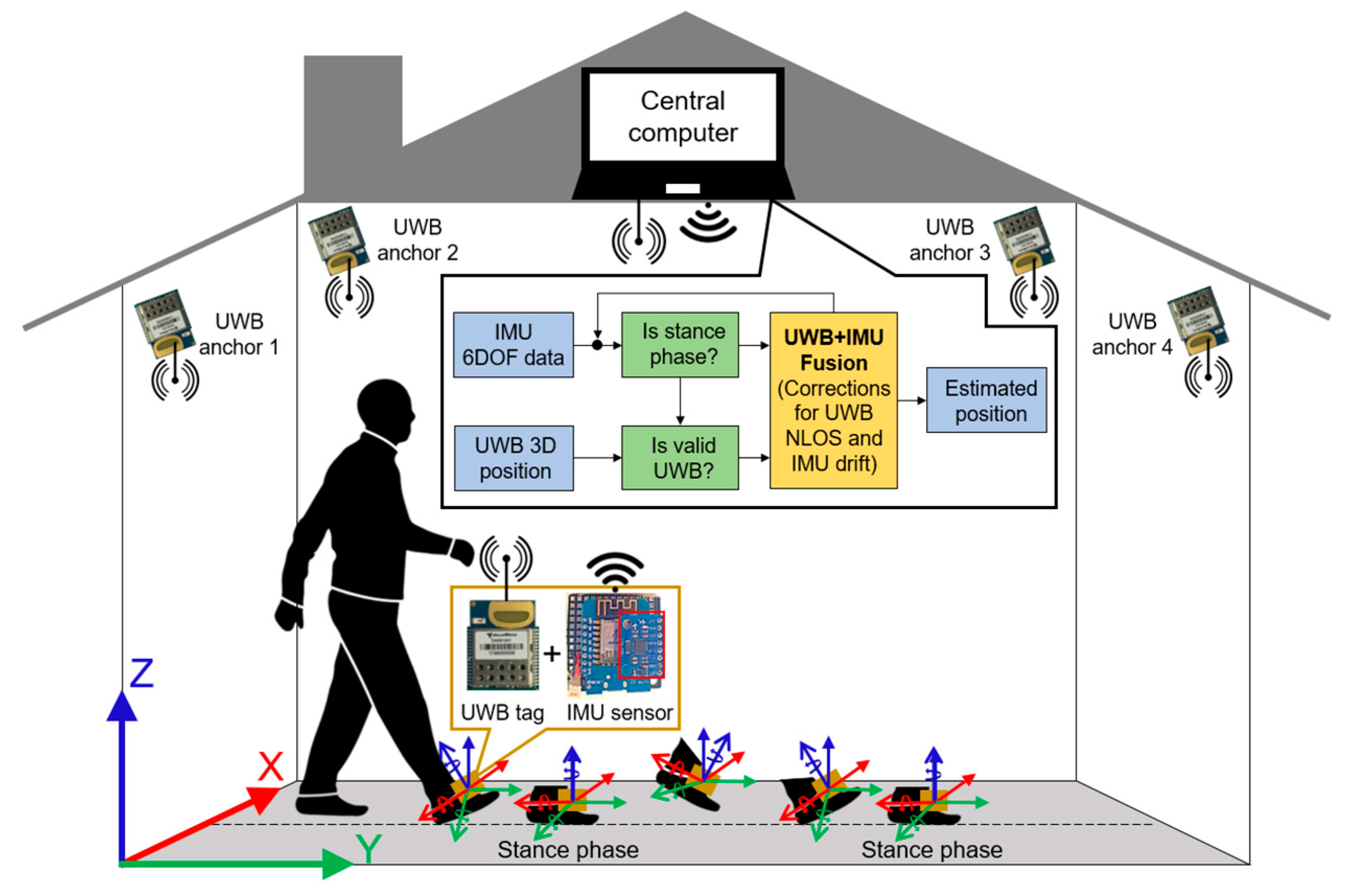
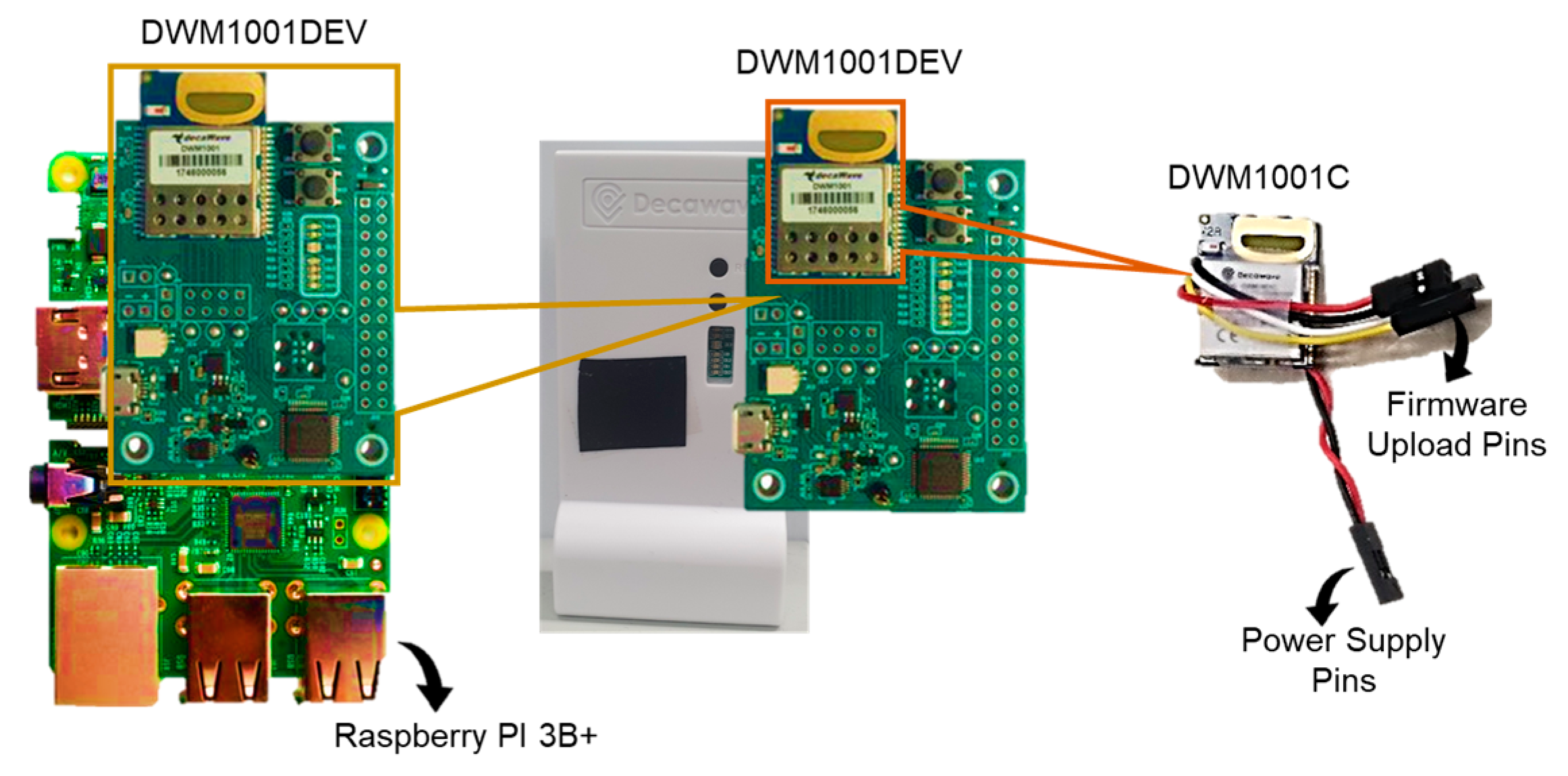
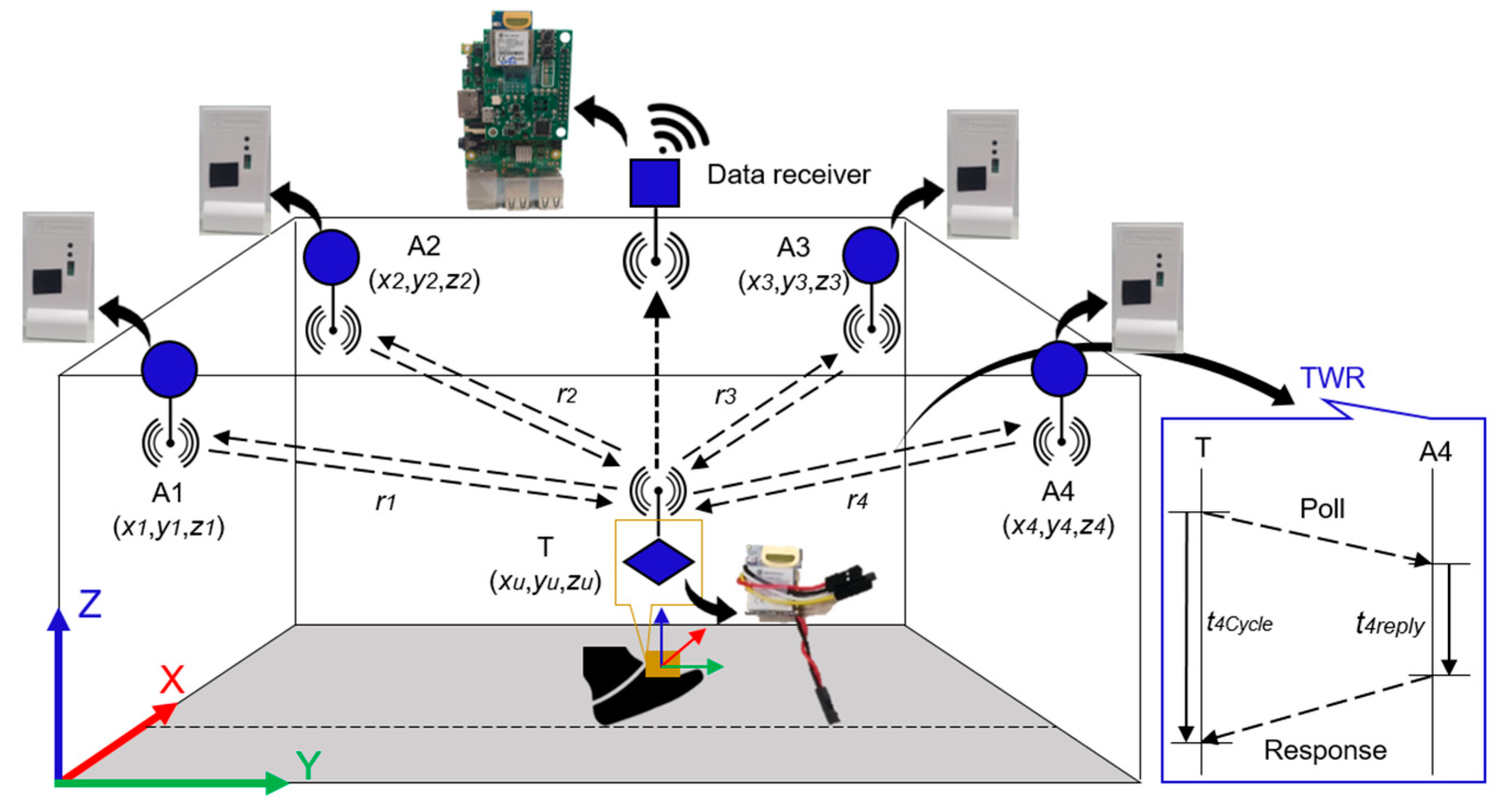



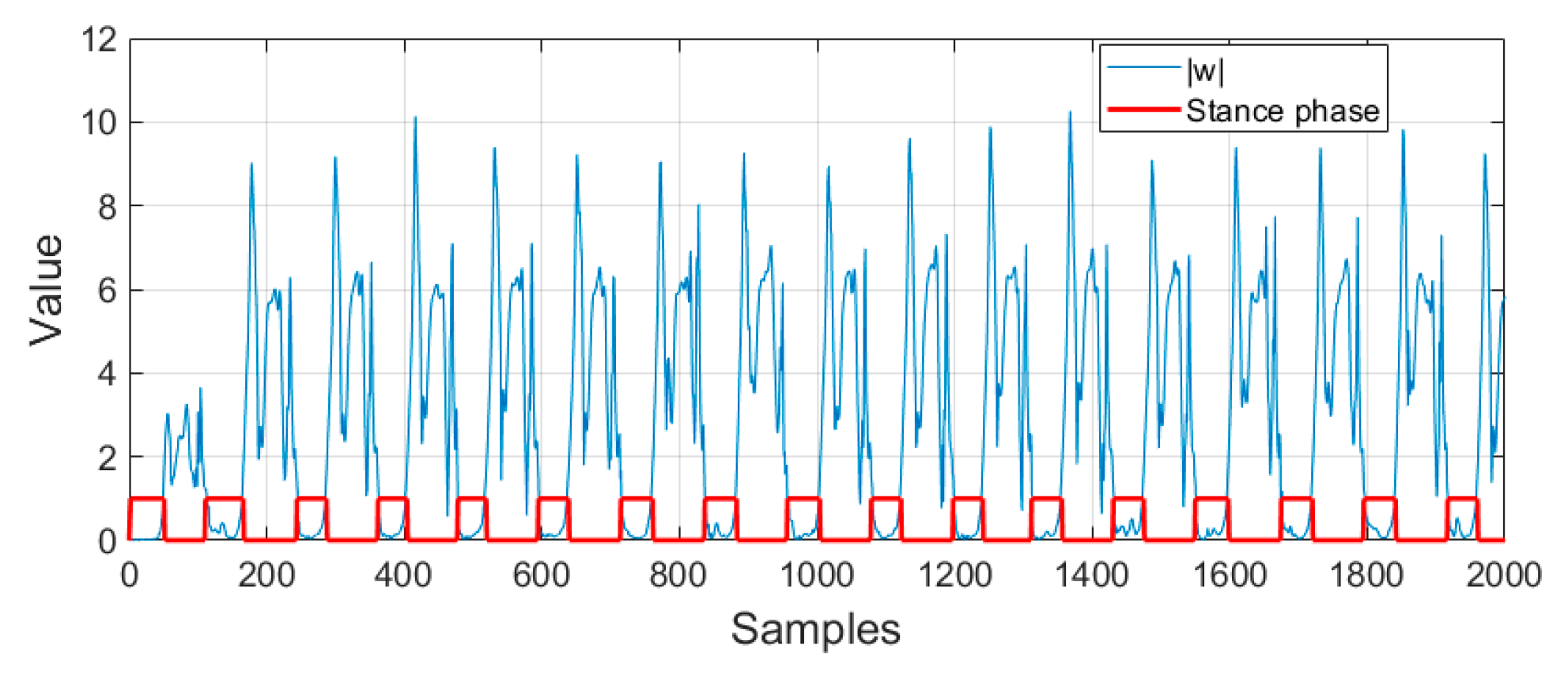
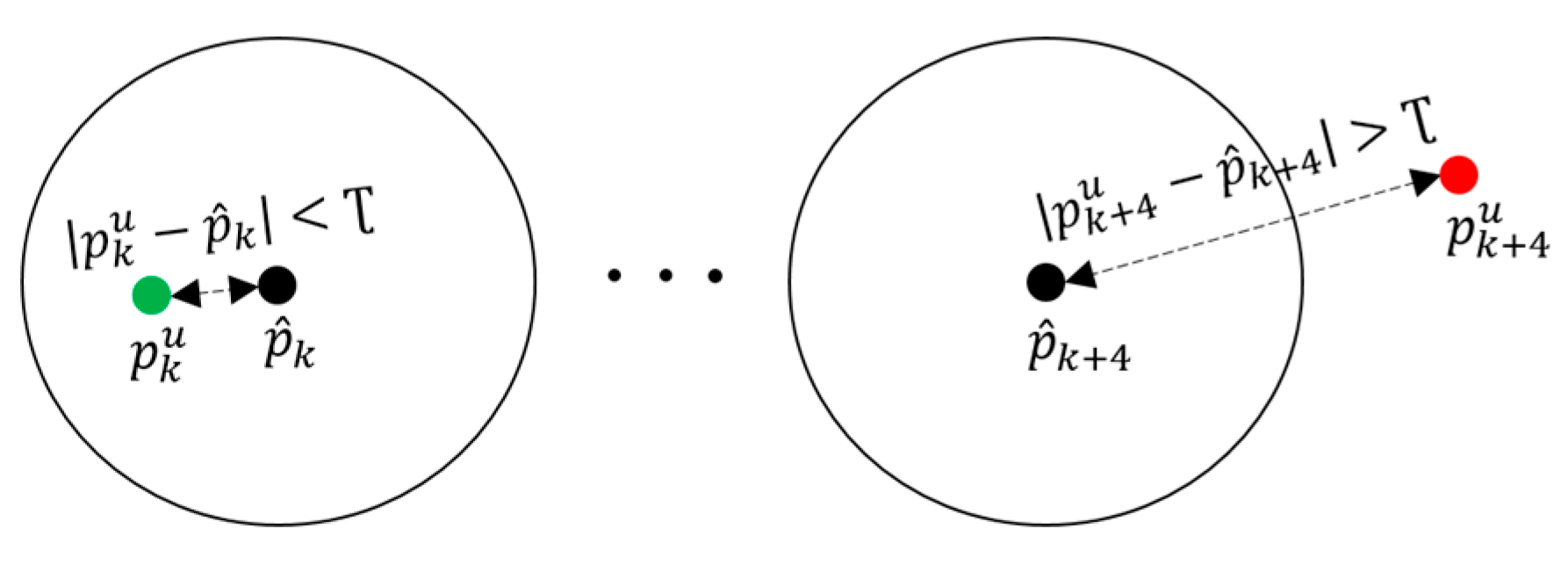
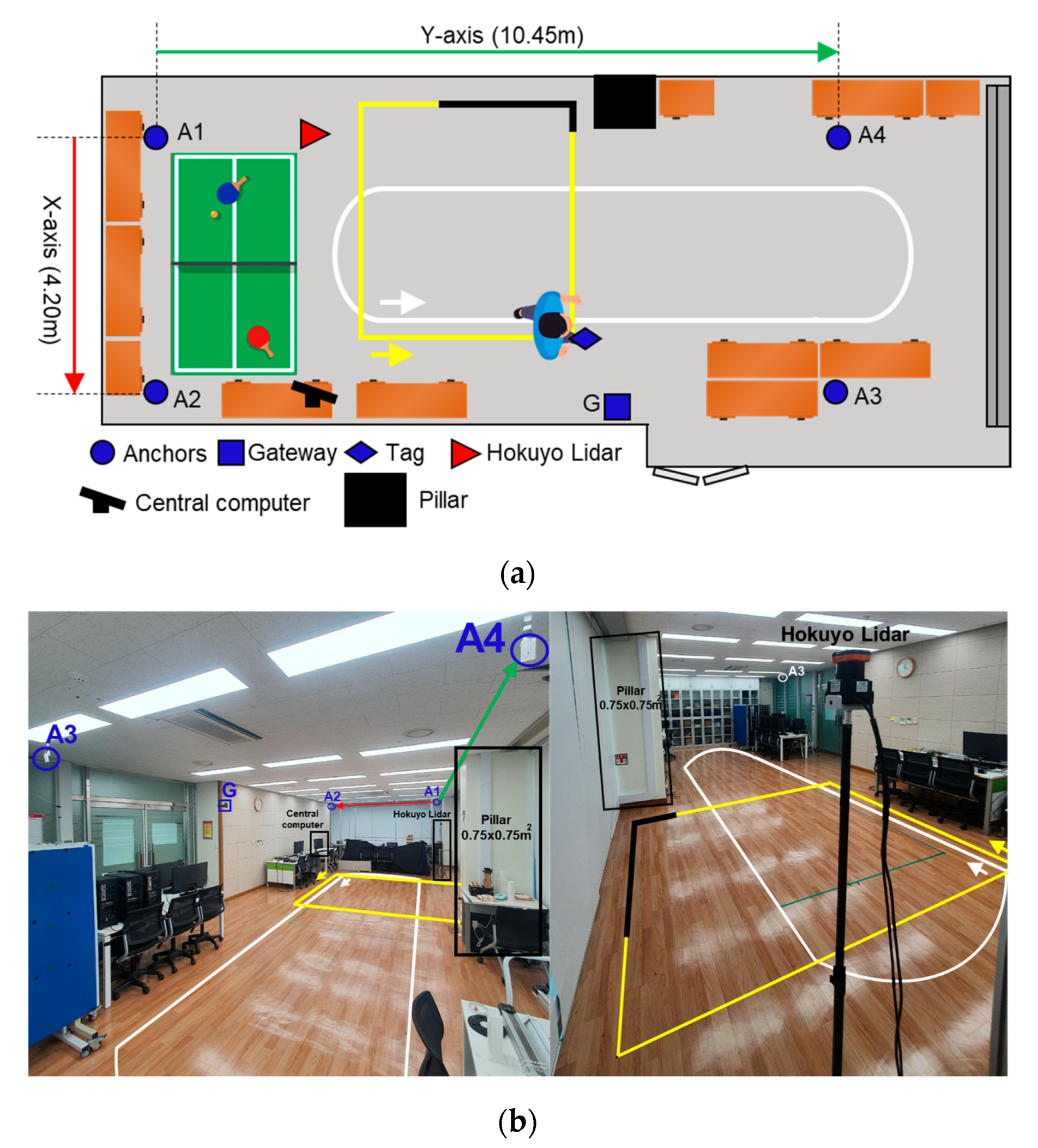
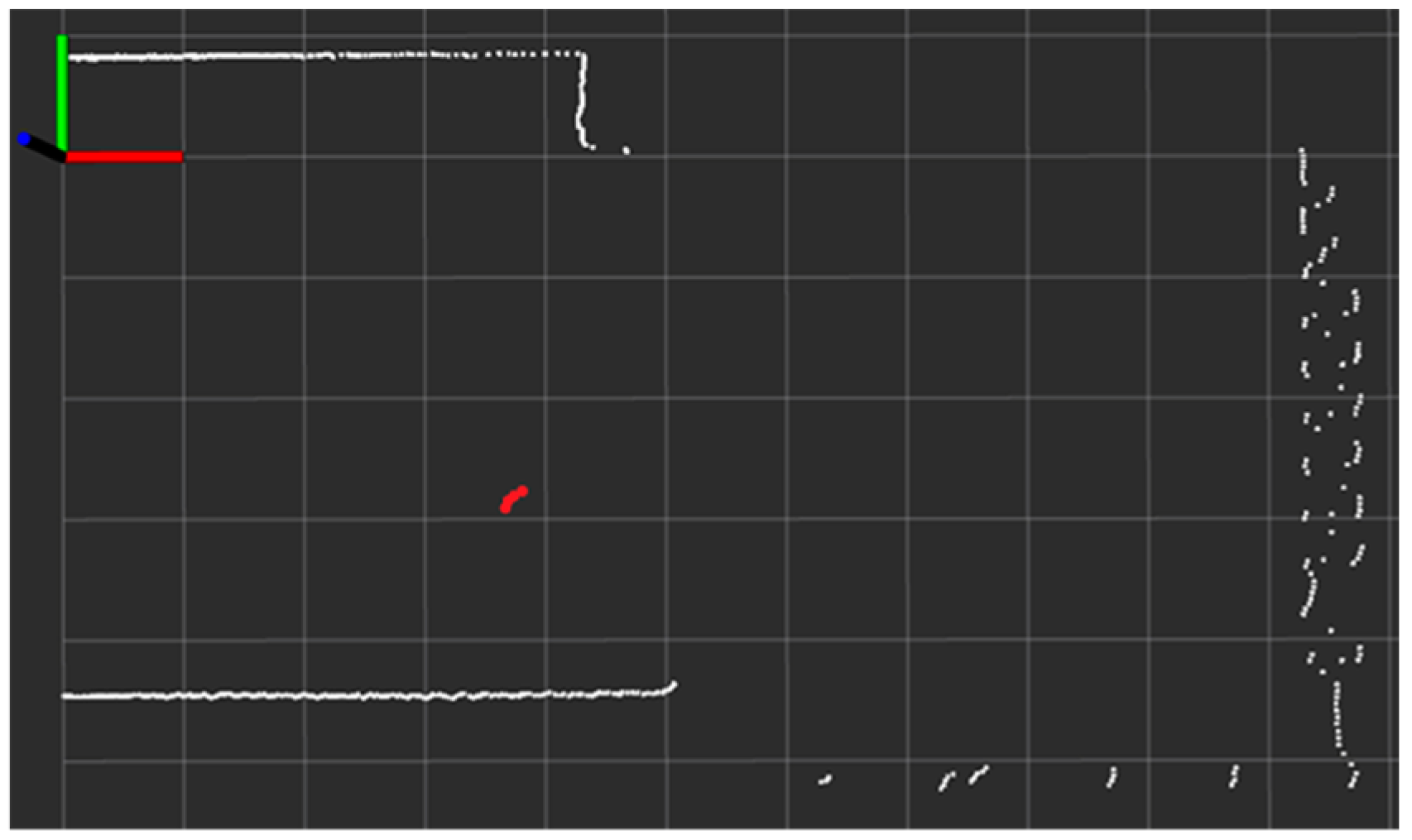
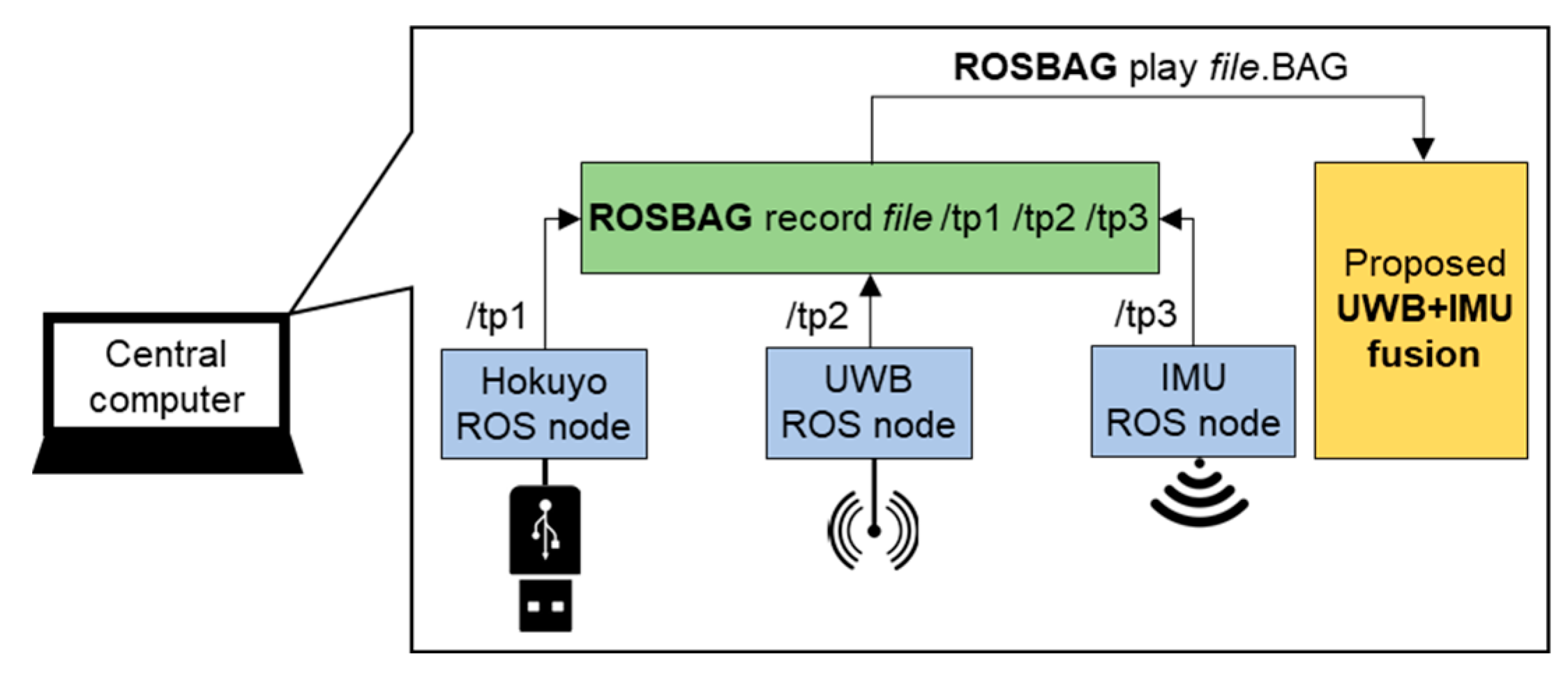

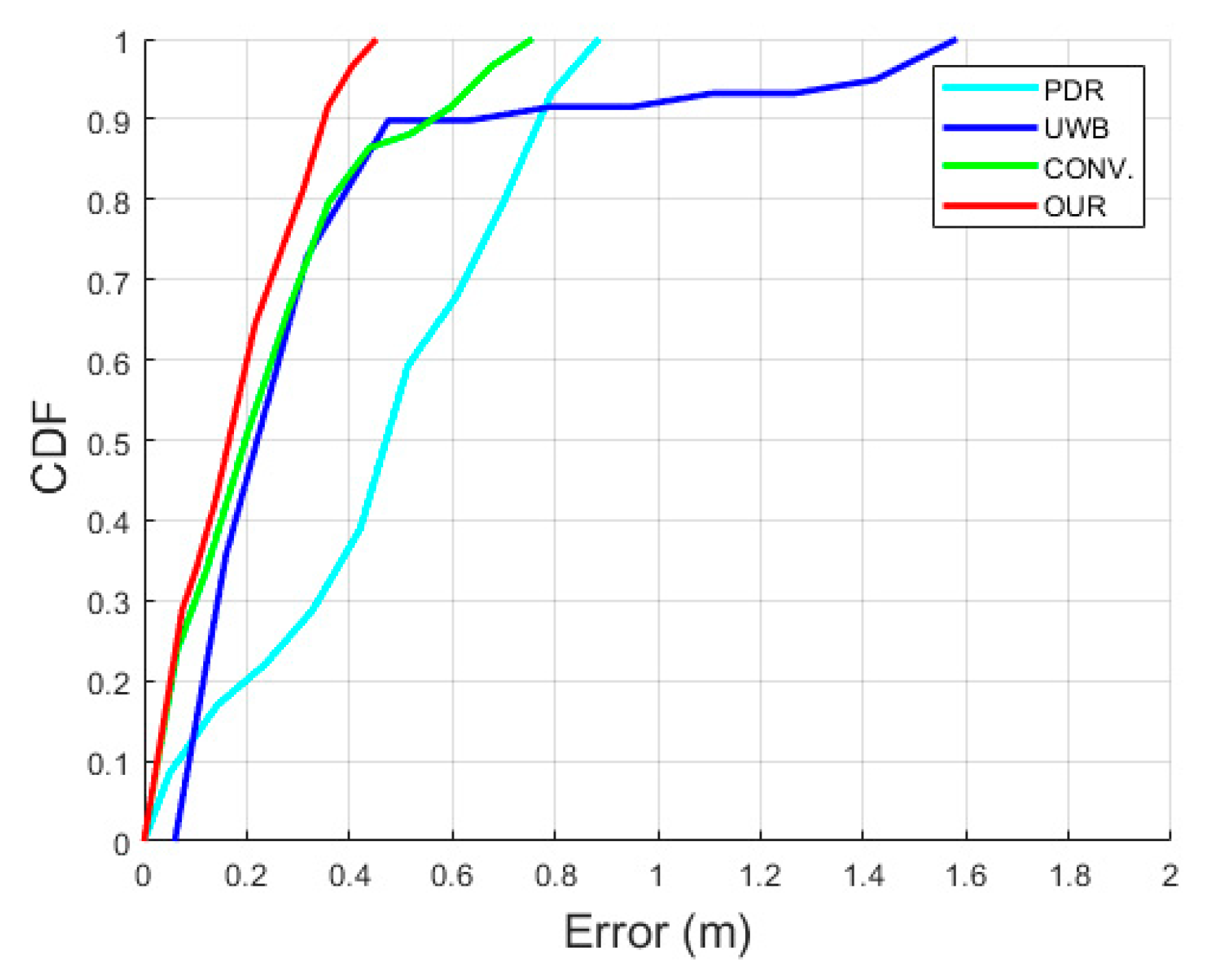
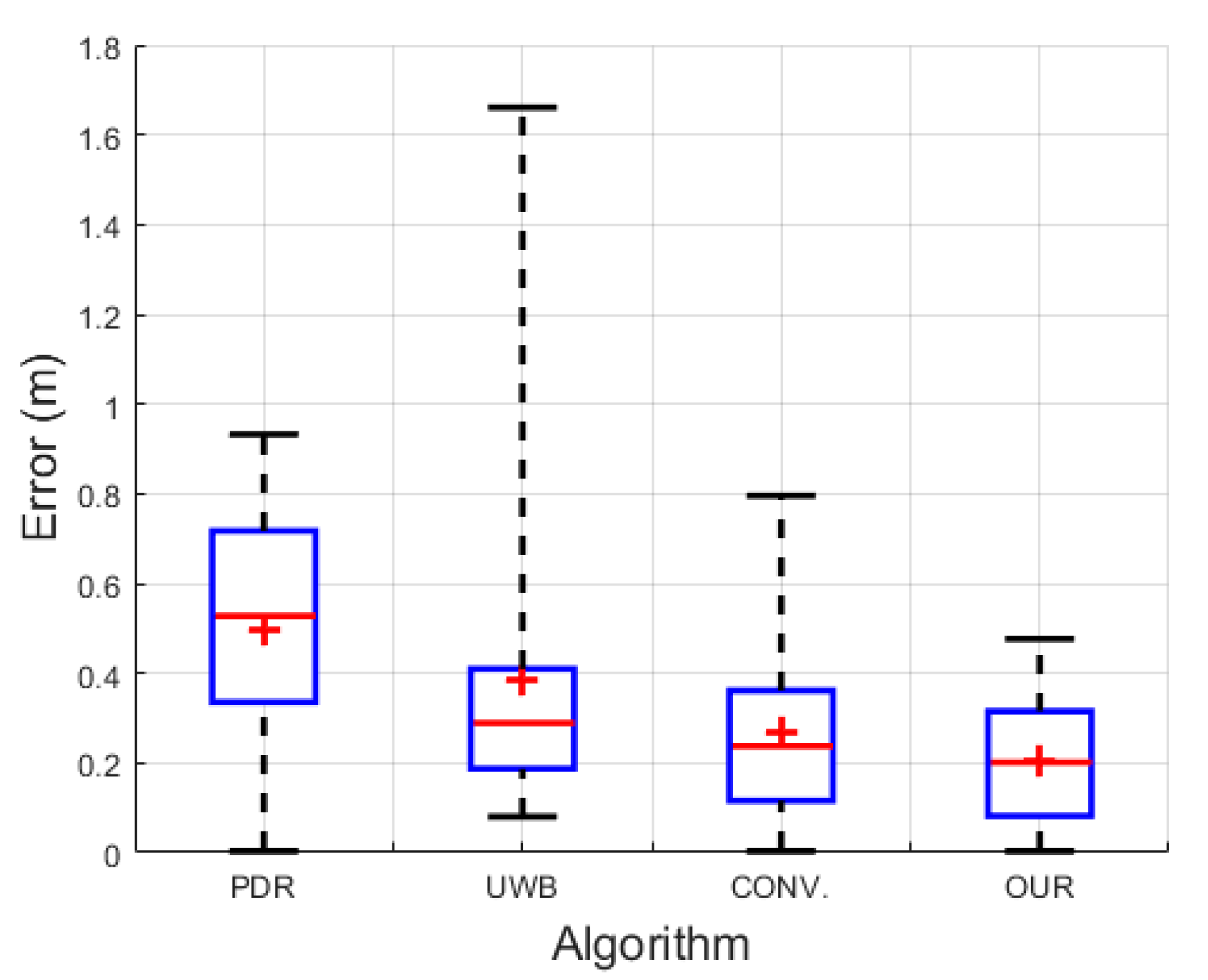
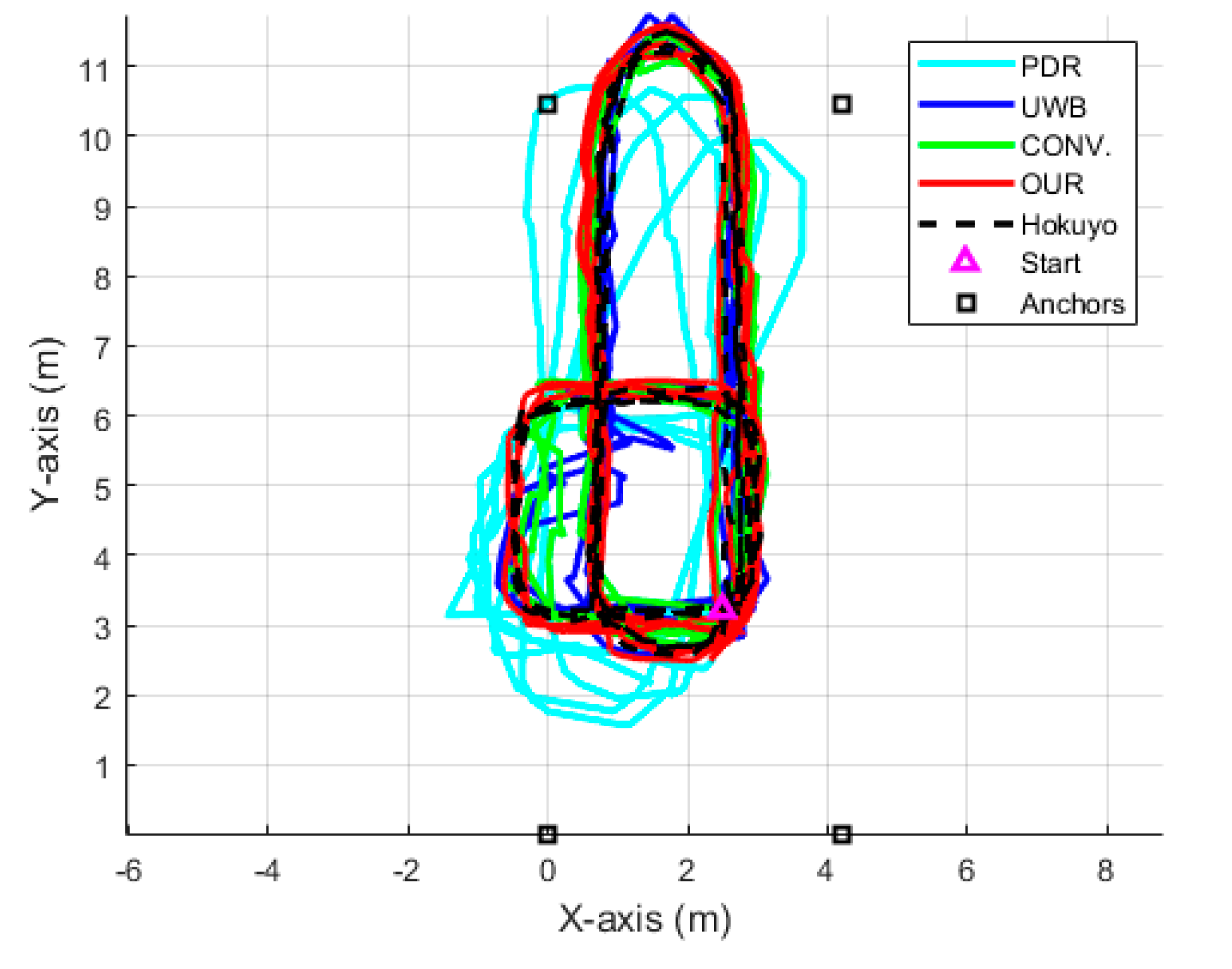

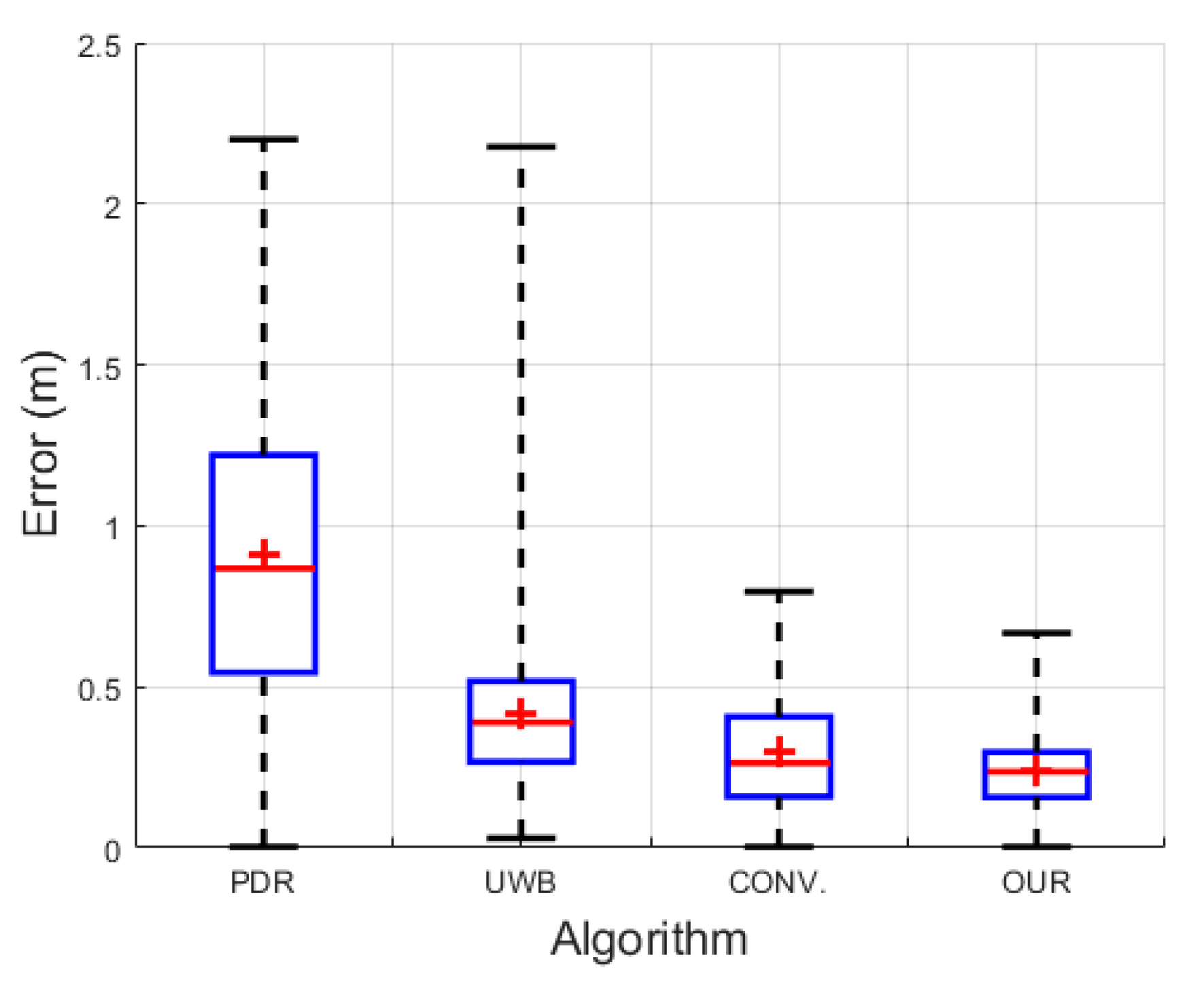
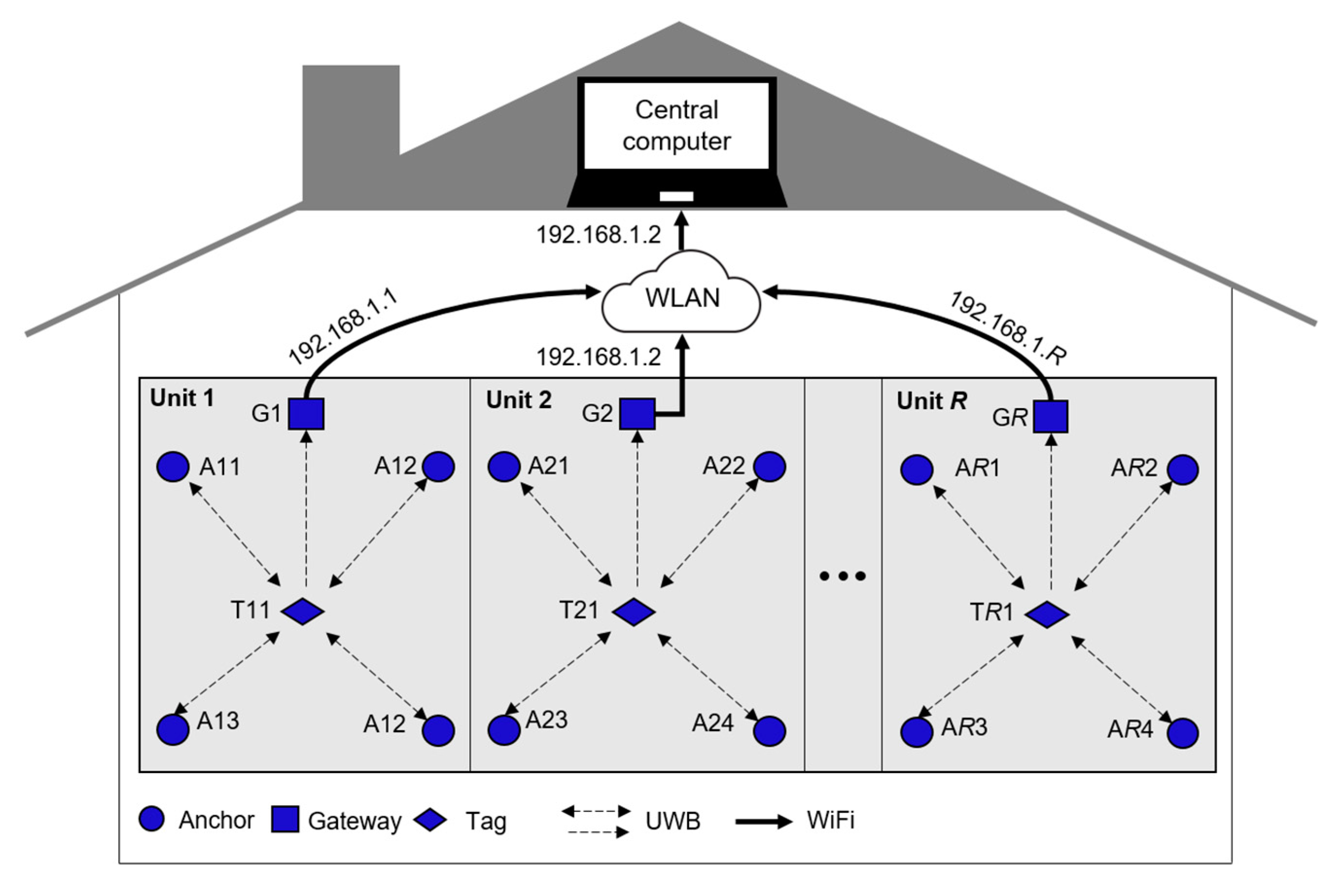
| Device Name | Dimensions | Price |
|---|---|---|
| DWM1001C | 26.2 mm × 19.1 mm × 2.6 mm | USD 18 [32] |
| MPU6050 | 21.2 mm × 16.4 mm × 3.3 mm | USD 4 [33] |
| D1MINI | 34.2 mm × 25.6 mm × 7.0 mm | USD 5 [33] |
| Lithium battery 650mAh | 35.0 mm × 20.0 mm × 10.0 mm | USD 3 [33] |
| Coordinate Value | Anchor Number | Hokuyo Lidar | |||
|---|---|---|---|---|---|
| A1 | A2 | A3 | A4 | ||
| x-axis (m) | 0 | 4.20 | 4.20 | 0 | 0 |
| y-axis (m) | 0 | 0 | 10.45 | 10.45 | 2.30 |
| z-axis (m) | 2.51 | 2.51 | 2.51 | 2.51 | 1.70 |
| Algorithm | 2D (m) | x-axis (m) | y-axis (m) | Mean (m) | Med. (m) | Max. (m) |
|---|---|---|---|---|---|---|
| PDR | 0.60 | 0.53 | 0.28 | 0.49 | 0.52 | 0.93 |
| UWB | 0.52 | 0.50 | 0.17 | 0.38 | 0.28 | 1.66 |
| CONV. | 0.33 | 0.29 | 0.16 | 0.26 | 0.23 | 0.80 |
| OUR | 0.24 | 0.18 | 0.15 | 0.20 | 0.20 | 0.47 |
| Algorithm | 2D (m) | x-axis (m) | y-axis (m) | Mean (m) | Med. (m) | Max. (m) |
|---|---|---|---|---|---|---|
| PDR | 1.02 | 0.71 | 0.73 | 0.91 | 0.86 | 2.20 |
| UWB | 0.46 | 0.35 | 0.29 | 0.41 | 0.38 | 2.17 |
| CONV. | 0.34 | 0.21 | 0.26 | 0.29 | 0.26 | 0.80 |
| OUR | 0.29 | 0.18 | 0.24 | 0.24 | 0.24 | 0.66 |
Publisher’s Note: MDPI stays neutral with regard to jurisdictional claims in published maps and institutional affiliations. |
© 2022 by the authors. Licensee MDPI, Basel, Switzerland. This article is an open access article distributed under the terms and conditions of the Creative Commons Attribution (CC BY) license (https://creativecommons.org/licenses/by/4.0/).
Share and Cite
Naheem, K.; Kim, M.S. A Low-Cost Foot-Placed UWB and IMU Fusion-Based Indoor Pedestrian Tracking System for IoT Applications. Sensors 2022, 22, 8160. https://doi.org/10.3390/s22218160
Naheem K, Kim MS. A Low-Cost Foot-Placed UWB and IMU Fusion-Based Indoor Pedestrian Tracking System for IoT Applications. Sensors. 2022; 22(21):8160. https://doi.org/10.3390/s22218160
Chicago/Turabian StyleNaheem, Khawar, and Mun Sang Kim. 2022. "A Low-Cost Foot-Placed UWB and IMU Fusion-Based Indoor Pedestrian Tracking System for IoT Applications" Sensors 22, no. 21: 8160. https://doi.org/10.3390/s22218160
APA StyleNaheem, K., & Kim, M. S. (2022). A Low-Cost Foot-Placed UWB and IMU Fusion-Based Indoor Pedestrian Tracking System for IoT Applications. Sensors, 22(21), 8160. https://doi.org/10.3390/s22218160









